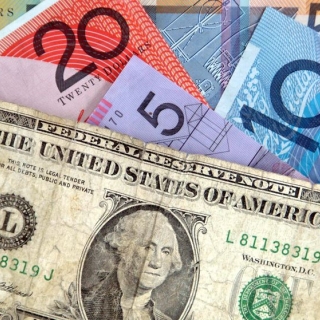


The Australian Dollar (AUD) strengthened during the American session on Wednesday (09/4), climbing to the mid-0.6100s as the US Dollar (USD) continued to weaken amid a risk-on rally in global markets. The currency pair rallied sharply after US President Donald Trump abruptly suspended most tariffs for 90 days, sparking a surge in equities and helping risk-sensitive currencies.
The minutes of the Federal Reserve's (Fed) March meeting, released during the session, revealed that policymakers were grappling with a "difficult compromise" due to persistent inflation pressures and a weakening growth outlook. From a technical perspective, AUD/USD remains tilted to the downside despite Wednesday's gains, as momentum indicators and moving averages continue to favor sellers.
Daily Market Movers Summary: US Dollar Holds Recovery After Fed Signals Caution
The US Dollar Index (DXY) held near the 103.00 area on Wednesday after a recent sharp decline, finding some stability following the release of the minutes of the Federal Reserve's March meeting. The minutes acknowledged an economic crossroads, highlighting that inflation risks could persist even as growth slows.
President Trump's unexpected move to halt most "reciprocal" and 10% tariffs for 90 days boosted market sentiment, lifting the Dow Jones above the 40,000 level in a historic surge. However, tariffs on China remained in place and were raised to 125% in response to Beijing's retaliatory 84% cut.
Fed officials were cautious, noting that uncertainties surrounding trade and inflation dynamics limit their ability to move quickly on interest rates. Richmond Fed's Barkin and St. Louis Fed's Musalem stressed that tariffs complicate the policy landscape and could delay future rate adjustments. Risk appetite has generally improved again as global investors cheered the temporary tariff relief. However, markets remain wary of ongoing trade tensions, especially given China's exclusion from the break. The AUD is benefiting from a weaker USD backdrop, but gains may be limited as trade disruptions weigh heavily on Australia's China-dependent export economy and support dovish RBA expectations. (Newsmaker23)
Source: FXstreet
The Australian dollar held steady around $0.651 on Thursday, holding onto recent gains after the September trade surplus widened sharply to AUD 3.94 billion (vs. August's revised AUD 1.11 billion), be...
The Australian dollar weakened to around $0.647, hitting its lowest level in eleven weeks. This decline continued as risk-off sentiment in global markets intensified, overshadowing the Reserve Bank of...
AUD/USD firms as traders brace for Australia Q3 inflation data and Fed decision The Australian Dollar (AUD) edges higher against the US Dollar (USD) on Tuesday, extending its winning streak for the f...
The Australian dollar (AUD) rose to around $0.656 on Tuesday, its highest level in nearly three weeks. This increase was primarily due to the weakening US dollar (greenback). US market participants aw...
The Australian dollar strengthened against the US dollar on Wednesday, recouping the previous session's losses. This boost came from comments by RBA Assistant Governor Sarah Hunter: recent data appear...
Oil prices declined on Thursday as investors considered a potential supply glut, as well as weakened demand in the United States, the world's largest oil consumer. Brent crude futures settled down 14 cents, or 0.22%, to $63.38 a barrel. U.S. West...
European stocks closed sharply lower on Thursday after a brief uptick the previous day as investors weighed a fresh round of mixed corporate earnings and signs of higher unemployment in the US. The STOXX 50 fell 1% to 5,613 and the STOXX 600 fell...
Gold (XAU/USD) edges lower on Thursday, after briefly reclaiming the key $4,000 psychological mark amid a weaker US Dollar (USD). At the time of writing, XAU/USD is trading around $3,985, easing from an intraday high of $4,019 as bullish momentum...
 Asian stocks opened lower on Tuesday, reversing Wall Street's rally fueled by Amazon's massive $38 billion deal with OpenAI. Stock markets in South...
Asian stocks opened lower on Tuesday, reversing Wall Street's rally fueled by Amazon's massive $38 billion deal with OpenAI. Stock markets in South...
 Asia-Pacific markets declined on Wednesday, following a decline on Wall Street, which was driven by concerns about the valuations of artificial...
Asia-Pacific markets declined on Wednesday, following a decline on Wall Street, which was driven by concerns about the valuations of artificial...
 The Institute for Supply Management (ISM) is scheduled to release its October Services Purchasing Managers' Index (PMI) on Wednesday. The report, a...
The Institute for Supply Management (ISM) is scheduled to release its October Services Purchasing Managers' Index (PMI) on Wednesday. The report, a...
 World markets kicked off November in an upbeat mood, riffing off buoyant company earnings and calmer trade relations while batting away OPEC's...
World markets kicked off November in an upbeat mood, riffing off buoyant company earnings and calmer trade relations while batting away OPEC's...